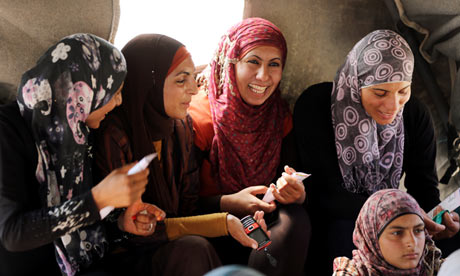General
How do we end violence against women and girls? It's the million dollar question. A multi-million dollar question, in fact, because gender-based violence is riding high on the development agenda for the first time, and funding commitments have followed.
However, while more money is available for programmes supporting women and girls, it's not reaching those who have the answer: women's rights organisations in developing countries.
In a report published on Thursday, the Commons international development committee urged the Department for International Development (DfID) to increase funding to women's organisations and look at channelling money through specific women's funds. DfID deserves credit for the work it has done on tackling the issue of violence against women and girls, but this is an area that needs further attention. Womankind, the women's rights charity for which I work, therefore welcomes the committee's report.
In 2010, just 1.3% of all funds dedicated to gender equality by the development assistance committee of the Organisation for Economic Co-operation and Development's (OECD) went to women's rights organisations. In 2011, a global survey of 1,119 women's organisations from more than 140 countries, conducted by the Association of Women's Rights in Development (AWID), found that only one-tenth of the organisations received funding from bilateral, national governments and international NGOs and only 3% from corporate funds.
Instead, the available funding is accessed by private sector consultancies and INGOs with more fundraising experience and capacity. "The space is getting crowded," one of Womankind's Zambian partners told us. "Local NGOs find it difficult to compete with better equipped and resourced INGOs for profile and networking opportunities with donors ... and therefore funds."
Many of our partners describe how INGOs with in-country offices often access funds and then "sub-contract" local organisations to deliver the work, treating them as contractors rather than innovators and experts. Women's rights organisations tend to lose out at this stage, too, as one of our partners in Sierra Leone explained: "Where donors or INGOs are supporting local NGOs to implement women's rights programmes they tend to support mainstream organisations rather than women's rights organisations as they feel they have more organisational capacity. This results in a catch-22 [situation], as women's rights organisations will continue to be sidelined if they do not receive support from donors to strengthen."
Fierce competition for funds and an uneven playing field are not the only barriers facing women's rights organisations. Changing trends in funding, away from core funding – which can be used to run an office, buy a computer and pay staff – and towards donor pooling and short-term, project-based support, have had a huge adverse impact. AWID research revealed that only 28% of women's rights organisations surveyed received core funding in 2010; nearly half had never received any. Piecemeal, project-based funding prevents organisations from developing their capacity and independent political strategy, making it hard for them to scale up innovative models and approaches, or do the slow but vital work of changing attitudes. Instead, their energy and resources are directed towards delivering short-term projects that, unsustainable in the longer-term, often reflect the priorities of donors rather than constituents' needs.
Better support for local women's rights organisations could be the catalyst needed to drive significant change; research has shown that strong women's movements are key to ending gender-based violence.
Women's rights organisations are uniquely placed to mobilise and empower, enabling women to come together to know and claim their rights. They are a crucial source of knowledge and innovation and have pioneered effective models for tackling violence – such as women's police stations and family courts – that have been widely adopted. Their very existence affirms women's leadership and participation, and reflects their priorities.
The international development committee report agrees that challenging the attitudes and social norms that perpetuate violence is essential to building a safer world for women and girls. But this is long-term, intensive work that is most effective when it is driven from within communities. This structural work – effectively shifting gender power relations – is impossible while the organisations best placed to deliver it are struggling to cover core costs with fragmented, short-term funding.
Womankind's "Leaders for change" briefing makes several recommendations for improving support to women's rights organisations, including the provision of long-term core funding, mechanisms to ensure funding reaches grassroots organisations, and simplifying grants application, monitoring and reporting processes to make them more accessible.
Women's rights organisations in the developing world have the experience and expertise needed to transform gendered social norms and power relations, and bring us closer to a world in which all women and girls can live free from violence. But while they are struggling to survive, the million dollar question could remain unanswered.

